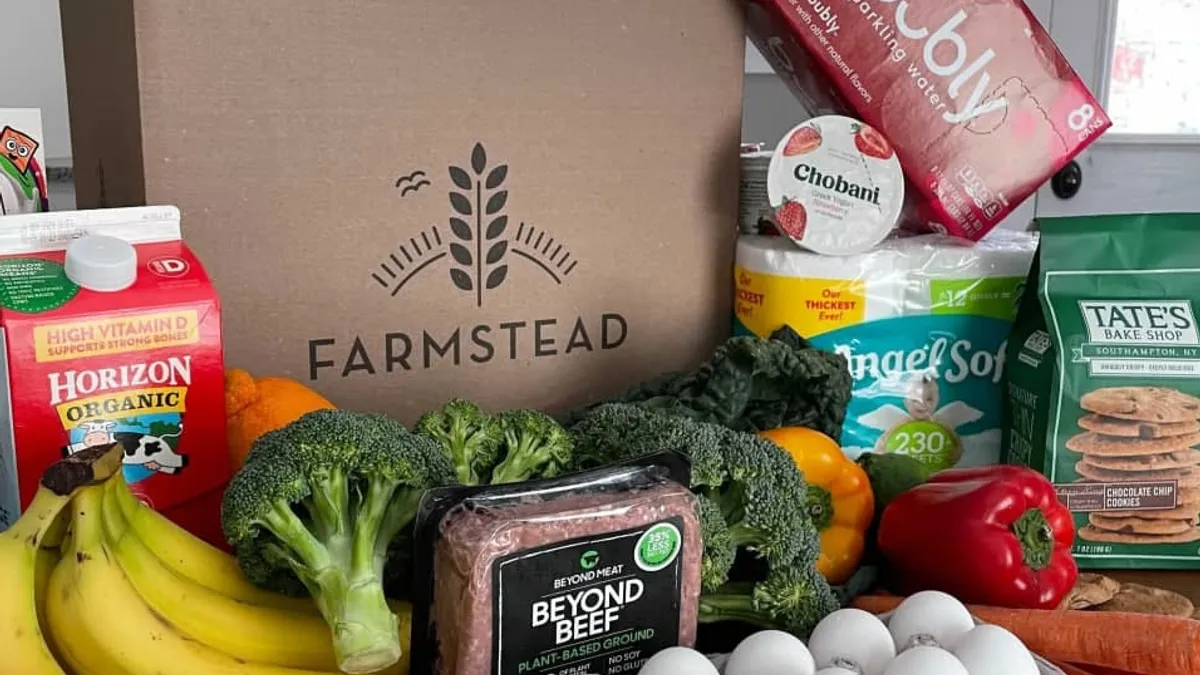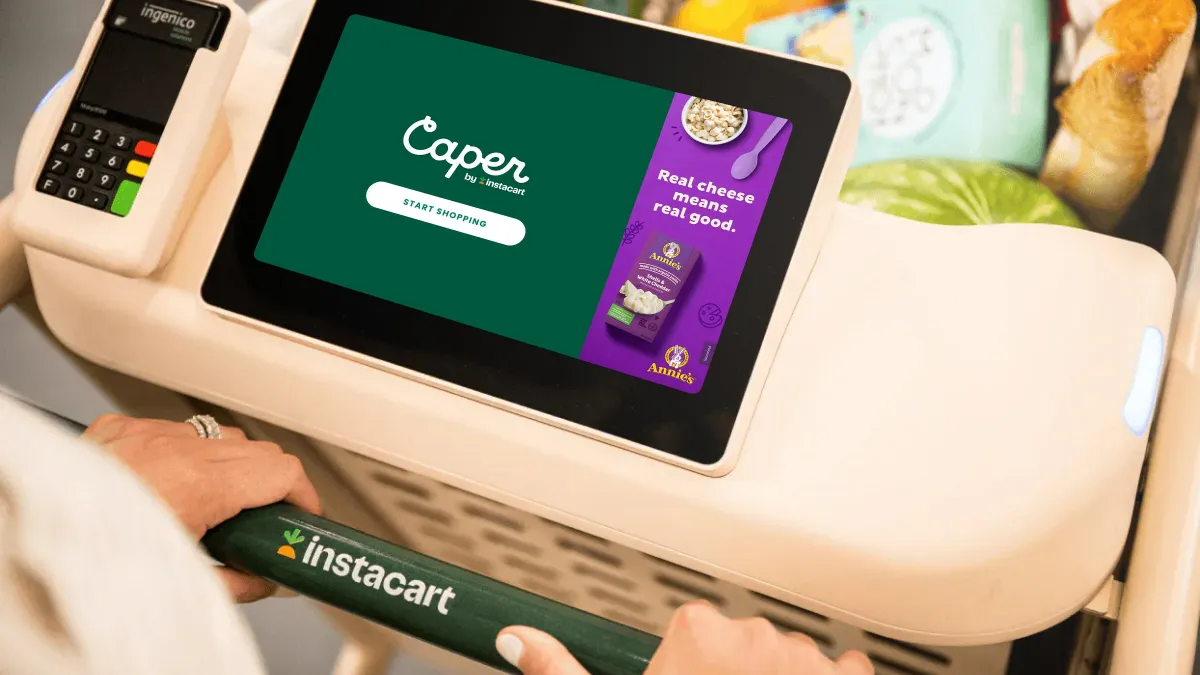Online grocer Farmstead has been successful offering free delivery and low prices on a curated grocery assortment in its native San Francisco Bay Area. But that’s more or less to be expected in a region chock full of affluent, digitally native consumers.
Much harder would be proving the pure-play’s model in a mid-market city all the way across the country, as Farmstead did when it opened for business in Charlotte, North Carolina, last year. It’s a seemingly risky bet. Whereas other online grocers serving local demand typically stick close to their home turf or target high-earning cities, Farmstead chose a far away market where the median household income is roughly equivalent to the national average, and where many shoppers are loyal to their local supermarket.
Four months in, the results are promising. Farmstead has so far delivered groceries to more than 5,000 households, with average order size increasing 35% since its launch in November, ahead of estimates it initially set out, said Pradeep Elankumaran, the company's co-founder and CEO. It has around 30 workers picking, packing and delivering at this point but expects to bring on hundreds more in the coming months.
The grocer initially got off on the wrong foot. Elankumaran said Farmstead started out offering nonperishable goods and price variety in categories like potato chips that customers didn’t want. But the company iterated quickly and found demand for perishables and a more curated assortment of products more closely matched what it sees in the Bay Area.
Once Farmstead made these tweaks, said Elankumaran, sales began to balloon.
“The more we refined the SKU mix, the higher the basket went,” he said, noting the experience helped Farmstead develop a "starter pack" of products it plans to use when opening in other cities.
There are still some key differences between the two markets. Charlotte shoppers have more meat options and more product categories overall to choose from compared to the Bay Area. Elankumaran said Farmstead polls its shoppers regularly and constantly crunches data. It sources local offerings wherever it can and offers a curated assortment of around 1,500 products.
Now the company is expanding its delivery services in Charlotte. It's moving from operating five days a week to seven, offering more two-hour time slots and extending service to shoppers who live within an hour of its 32,000-square-foot warehouse located near the city’s airport. This extends its service into Charlotte's suburbs, whereas before it was focused just within city limits.
Farmstead is also now offering the same one-hour delivery service in Charlotte that it provides on the West Coast, along with a referral program that rewards shoppers who spread the word about the company.
It’s a service expansion blueprint Farmstead plans to implement in other markets, as well. On Friday, Farmstead added Austin, Texas, to its list of expansion cities. The company plans to go live in the Lone Star state sometime this summer, and has opened a service waitlist capped at 1,000 shoppers. Farmstead will also begin delivering orders in Nashville, Tennessee, and Miami in the coming weeks. In March, the grocer began delivering in Raleigh-Durham, North Carolina.
Along with these cities, Farmstead said it plans to expand to at least 10 additional markets in 2021.
Proving the mid-market thesis
The strong results in its first market beyond the Bay Area bolster Elankumaran’s thesis that grocery delivery isn’t just a service that's popular with affluent shoppers. Farmstead is taking aim at mass-market households that are often loyal to their local supermarket, but who also shop around for good prices and prize quality and consistency. These consumers, who Elankumaran said comprise as much as 70% of the U.S. population, have a weekly grocery budget of between $100 and $150 a week.
“You can’t ask them to spend 15% or 20% more in a week," he said. "That $20 can get them a lot of extra food.”
When it evaluates new markets, Farmstead looks not at income levels but at addressable market size and population growth over the past few years, Elankumaran said. Charlotte and Raleigh-Durham, its second and third markets, have seen an influx of young consumers lately, as have other markets it plans to move into this year, like Miami, Austin and Nashville.
However, gaining their loyalty means ensuring they don’t have to make any trade-offs on price and quality. To that end, Farmstead doesn’t charge fees on orders over $35 and offers pricing that’s competitive with local chains like Harris Teeter and Food Lion. It also offers customers 5% off on items they order weekly.
Farmstead’s pricing and service strategy involves spinning up a flywheel of proprietary systems and machine learning software that results in efficiency feeding consumer demand, and vice versa. The company uses artificial intelligence to optimize its ordering and prevent overbuying, which offers the added benefit of ensuring fresher products. Its San Francisco delivery hub sees just 2% of food go to waste. The company also employs its own picking and delivery routing technology — part of the Grocery OS system it’s marketing to other grocers — that shaves costs, which it can in turn plow into pricing.
The more customers it handles, the better the system gets at ordering and predicting demand, Elankumaran said. "The system knows to be careful about buying too much basil because basil is expensive and highly perishable, but it can order a lot of milk because it moves fast."
To keep operational costs down, Farmstead also makes sure to grow into the markets where it lands. Its Charlotte warehouse can handle more than 4,000 orders a day, but it started out with enough pickers and drivers to handle around 100 orders. Elankumaran declined to note how many daily orders the facility currently processes.
Online grocery services have a reputation for being costly to operate. Elankumaran noted this is certainly the case for brick-and-mortar grocers, which have to sidestep their way into the business. But pure-play grocers don’t have the same structural burdens.
"A supermarket costs somewhere between $5 million to $10 million minimum to open the doors on day one, and it takes two years to get to a break-even point," Elankumaran said. "But we're talking about very low hundreds of thousands of dollars in total cap [expenditure] and on day one we need only spend about $100,000 to open the doors."
Farmstead has so far raised $14.5 million through investors like Y Combinator and Aidenlair Capital.
E-commerce consulting firm Brick Meets Click noted in a recent blog post that Farmstead’s mass-market model, which doesn’t yet rely on robotics, is worth watching. “They are important to watch because their focus on cracking the grocery delivery profitability challenge appears to be working,” the firm wrote.
Farmstead's early wins are by no means a guarantee of success. In each of its new markets it will face the unenviable task of prying shoppers away from legacy grocers. In North Carolina, it faces off against Publix, Lidl, Walmart and numerous other competitors that have large marketing budgets and can drive down pricing to compete. In Austin, it will have to convince shoppers to divert dollars away from ultra-popular H-E-B and beloved local grocers.
But Elankumaran said the pandemic has created a whole new playing field in online grocery. Bolstered by strong early results, he said Farmstead will continue trying to prove its theory that e-grocery is a service the majority of U.S. consumers will adopt long-term.
“We're trying to shape a new profile of local shopper who cares about price, who cares about quality, who cares about convenience, that is somewhat distinct and adjacent to the profiles that are already out there of who the U.S. shopper is," Elankumaran said. "I think nobody honestly really knows what the U.S. grocery shopper looks like anymore. And history is not a good guide."




















